जीवन-यात्रा
 टेस्सिटोरी का जन्म 13 दिसंबर 1887 को उडीन के उत्तर-पूर्वी इतालवी शहर में हुआ था, जो गुइल्डे टेस्सिटोरी, फाउंडलिंग अस्पताल के एक कार्यकर्ता और लुगिया रोजा वेनियर रोमानो के घर में हुआ था। विश्वविद्यालय जाने से पहले उन्होंने लिसो क्लासिको जैकोपो स्टेलिनी में अध्ययन किया। उन्होंने फ्लोरेंस विश्वविद्यालय में अध्ययन कर, 1910 में मानविकी में अपनी डिग्री प्राप्त की। वे एक शांत छात्र थे और उन्होंने संस्कृत, पाली और प्राकृत का अध्ययन किया। उनकी भारतीय संस्कृति और साहित्य में अत्यअधिक रूची होने के कारण उनके सहपाठी उन्हें भारतीय “लुई”(योद्धा) उपनाम से संबोधित करते थे।
टेस्सिटोरी का जन्म 13 दिसंबर 1887 को उडीन के उत्तर-पूर्वी इतालवी शहर में हुआ था, जो गुइल्डे टेस्सिटोरी, फाउंडलिंग अस्पताल के एक कार्यकर्ता और लुगिया रोजा वेनियर रोमानो के घर में हुआ था। विश्वविद्यालय जाने से पहले उन्होंने लिसो क्लासिको जैकोपो स्टेलिनी में अध्ययन किया। उन्होंने फ्लोरेंस विश्वविद्यालय में अध्ययन कर, 1910 में मानविकी में अपनी डिग्री प्राप्त की। वे एक शांत छात्र थे और उन्होंने संस्कृत, पाली और प्राकृत का अध्ययन किया। उनकी भारतीय संस्कृति और साहित्य में अत्यअधिक रूची होने के कारण उनके सहपाठी उन्हें भारतीय “लुई”(योद्धा) उपनाम से संबोधित करते थे।
भारत में प्रथम नियुक्ति:
उत्तर भारतीय स्थानीय भाषाओं में एक अभिरुचि विकसित होने के बाद, टेस्सिटोरी ने राजस्थान में एक नियुक्ति प्राप्त करने के लिए कड़ी मेहनत की। उन्होंने 1913 में इंडिया ऑफिस में आवेदन किया, यह समझते हुए कि नौकरी की कोई गारंटी नहीं थी। उन्होंने भाषाई कार्य की नियुक्त के लिए भारतीय राजाओं से भी संपर्क किया। इस समय के दौरान, उन्होंने एक जैन 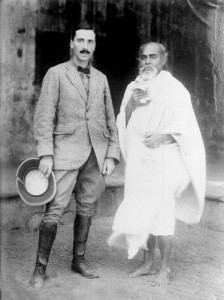 शिक्षक, विजया धर्म सूरी (1868-1923) के साथ संपर्क स्थापित किया, जिनके साथ उनका घनिष्ठ व्यक्तिगत और व्यावसायिक संबंध थे। सूरी जैन साहित्य के अपने गहन ज्ञान के लिए जाने माने जाते थे और उन्होने जैन साहित्य के कई कार्यों की पुनर्प्राप्ति और संरक्षण में महत्वपूर्ण भूमिका निभाई थी।
शिक्षक, विजया धर्म सूरी (1868-1923) के साथ संपर्क स्थापित किया, जिनके साथ उनका घनिष्ठ व्यक्तिगत और व्यावसायिक संबंध थे। सूरी जैन साहित्य के अपने गहन ज्ञान के लिए जाने माने जाते थे और उन्होने जैन साहित्य के कई कार्यों की पुनर्प्राप्ति और संरक्षण में महत्वपूर्ण भूमिका निभाई थी।
सूरी ने उन्हें राजस्थान के एक जैन स्कूल में एक पद की पेशकश की। एक विदेशी ईसाई का, जैन समुदाय में रहने वाली नाजुक स्थिति के बारे में जानते हुए भी टेस्सिटोरी ने इंडिया ऑफिस से आवेदन कर के स्वीकृति प्राप्त की और वे 1914 में भारत आ गये। भारत पहुचंने पर वे भाषाई सर्वेक्षण और पुरातत्व सर्वेक्षण दोनों के साथ घनिष्ठ रूप से जुड़ गये और उनके द्वारा किया अनवेषण इंडोलॉजी या भारत-विद्या के लिए एक मौलिक महत्व की खोज बन गया।
माँ की गंभीर बीमारी की खबर पा कर के वे 17 अप्रैल 1919 में इटली के लिए रवाना हुए। लेकिन जब तक वे इटली पहुंचे, तब तक उनकी माँ का देहाँत हो चुका था। कई महीनों तक इटली में रह कर जब वे नवंबर में जहाज से भारत लौट रहे थे तब दुर्भाग्य से उन्हे स्पेनिश इन्फ्लूएंजा हो गया और वे गंभीर रूप से बीमार पड़ गये। 22 नवंबर 1919 को बीकानेर में उनकी मृत्यु हो गई।
शोध और प्रारम्भिक कार्य
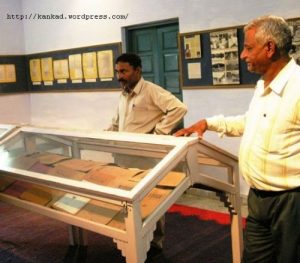 वाल्मीकिजी और तुलसीदासजी की रामायण पर शोध:
वाल्मीकिजी और तुलसीदासजी की रामायण पर शोध:
टेस्सिटोरी की विदेशी भाषाओं में स्वाभाविक रुचि थी और विश्वविद्यालय स्तर पर संस्कृत का अध्ययन करने के बाद वे फ्लॉरेंस विश्वविद्यालय से संस्कृत के स्नातक भी हुए। 1846 और 1870 के बीच वाल्मीकि रामायण के बंगाली या गौड़ा संस्करण के बारह खंड इटली में गैस्पेर गोरेसियो द्वारा प्रकाशित किए गए थे। जो इतालवी इंडीलॉजिस्ट के लिए एक महत्वपूर्ण संदर्भ बन गये। टेस्सिटोरी की थीसिस भी इनके काम पर आधारित थी।
उन्होने इसमें वाल्मीकि और तुलसीदास के संस्करण के बीच के संबंध का विश्लेषण किया था। उन्होंने इसमें दर्शाया कि लगभग एक हजार साल बाद अवधी में लिखी गई राम-चरित मानस में तुलसीदासजी ने वाल्मीकि से मुख्य कहानी उधार ली और फिर अपनी रूची के अनुसार विषय का विस्तार या कम कर के, एक काव्यात्मक रूप में प्रस्तुत किया जो कि मूल रूप से स्वतंत्र था और इसलिए इसे एक नया काम माना जा सकता है।
उन्होने दो संस्करणों की कविता-पद्य की तुलना कर के अपने श्रमसाध्य शोध में यह दर्शाया कि तुलसीदासजी ने उस समय भारत में मौजूद रामायण के विभिन्न संस्करणों का अनोखा मिश्रण किया था। उनकी थीसिस पाओलो एमिलियो पावोलिनी की देखरेख में प्रकाशित हुई। उन्होने 24 साल की उम्र में ही ‘रामचरित और रामायण’ विषय पर पहले इतालवी शोधार्थी होने का गौरव प्राप्त किया।
भाषाई सर्वेक्षण में योगदान
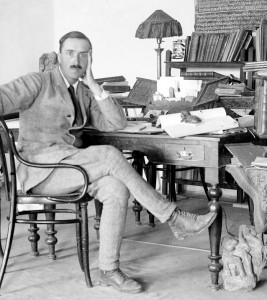 भारत में आगमन:
भारत में आगमन:
एशियाटिक सोसाइटी ऑफ़ बंगाल ने टेस्सिटोरी को अपने भाषाई सर्वेक्षण में शामिल होने के लिए आमंत्रित किया। उन्हें सर जॉर्ज ग्रियर्सन द्वारा राजपुताना के कवि या भाट संबंधी बर्दिक और ऐतिहासिक सर्वेक्षण का नेतृत्व करने का काम सौंपा गया था। वे 8 अप्रैल 1914 में आए और पांच साल तक राजपुताना में रहे। उन्होंने राजस्थान के मध्ययुगीन काल और कविताओं का अनुवाद किया और उन पर टिप्पणी की, जिनमें से कई का अध्ययन उन्होंने पहले फ्लोरेंस की राष्ट्रीय पुस्तकालय में किया था। उन्होने कई साहित्यक रचनाओं का समालोचनात्मक और समीक्षात्मक संपादन किया। जैसे राठौड़ पृथ्वीराज (वि. 1606) द्वारा वेलि क्रिसण रुक्मणी री, चरण दास (1760-1836) की नासकेत री और बीठू सूजो(1598) की राव जैतसी रो छंद इत्यादि।
टेस्सिटोरी ने डिंगला और पिंगला बोलियों और वंशावली कथाओं में काव्य रचनाओं की खोज की। उन्होंने कुछ नौकरशाही विरोध के बावजूद निजी बार्डिक लाइब्रेरी और कई राजकीय पुस्तकालयों को सूचीबद्ध करने में कामयाबी हासिल की।
पुरानी गुजराती और पुरानी पश्चिमी राजस्थानी का तुलनात्मक अध्ययन:
1915 में, बीकानेर के महाराजा द्वारा आमंत्रित, टेस्सिटोरी राजस्थान पहुंचे और क्षेत्रीय साहित्य का कोषगत (लेक्सिकोग्राफिक) और व्याकरणिक अध्ययन शुरू किया। वह यह दिखाने में सक्षम हुये कि पुरानी गुजराती नामक बोली के बोलने का ढंग से उसे पुरानी पश्चिमी राजस्थानी कहा जाना चाहिए।वे राजस्थानी बोलीयों की सुंदरता से अत्य अधिक प्रभावित थे। उन्होंने पुरानी राजस्थानी के व्याकरण का, उसी तुलनात्मक पद्धतियों के साथ अध्ययन किया जैसा कि उन्होंने अपनी थीसिस या शोध के साथ किया था। इस तरह उन्होने आधुनिक इंडो-आर्यन वर्नाक्यूलर या जातीय प्राकृत भाषा के विकास के इतिहास की नींव रखी।
बार्डिक संग्रहालय या लाइब्रेरी:
जहाँ महाकाव्य या वीर कवितायें, जिनको अक्सर वीणा, गीत, या किसी भी तरीके से गा कर सुनाया जाये, उन रचनाओं को संग्रहित करके रखा गया हो। एक प्राचीन सेल्टिक संगीतकार और कविता के लेखकों के क्रम में से कोई भी कवि जैसे बार्ड, विलियम शेक्सपियर।
बीकानेर के प्रसिद्ध अभिलेखागार में टेस्सिटोरी अभिलेख कक्ष बना हुआ है जिसमें उन से जुड़ी तमाम सामग्री का प्रदर्शन किया गया है। इस कक्ष की सामग्री हजारी लाल बांठिया ने उपलब्ध कराई हैं।
पुरातत्त्व में योगदान
डॉ. लुइगी पियो टेस्सिटोरी जब प्राचीन भारतीय ग्रंथों में कुछ शोध कर रहे थे तब उस क्षेत्र के खंडहरों की मौर्य पूर्व काल और हड़प्पा संस्कृति की समानता से वे हैरान थे। उन्होंने भारतीय पुरातत्व सर्वेक्षण के सर जॉन मार्शल से मदद मांगी। जो उस समय ए.एस.आई. हड़प्पा में खुदाई कर रहे थे, लेकिन वे खंडहरों के महत्व से अनजान थे। अपने भाषाई कार्य के साथ, टेस्सिटोरी ने भारतीय पुरातत्व सर्वेक्षण के सर जॉन मार्शल की ओर से स्मारक स्तंभों, मूर्तियों, सिक्कों और पुरातात्विक स्थलों की खोज में जोधपुर और बीकानेर की यात्रा की।
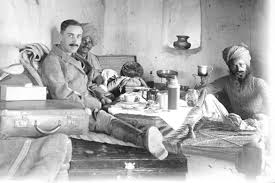 पूर्व मौर्य कालीन वस्तुयें:
पूर्व मौर्य कालीन वस्तुयें:
टेस्सिटोरी को रंगमहल और अन्य स्थानों के टीलों के खनन से गुप्तकाल की टेरकोटा वस्तुयें प्राप्त हुई, साथ ही गंगानगर के पास देवी सरस्वती की दो विशाल संगमरमर की मूर्तियाँ भी। उन्हें दुलामनी और गंगानगर में कुषाण-साम्राज्य के समय का टेराकोटा सामान मिला। उन्होंने जोधपुर-बीकानेर क्षेत्र में पत्थर (गोवर्धन) स्तंभों और शिलालेख या बीजलेखों के लेखों की संकेतावली को हल कर प्रकाशित किया। उन्होंने बीकानेर रियासत के सैकड़ों गांवों में घूमकर लगभग 729 पुरालेखों और लगभग 981 मूर्तियाँ तथा पुरातत्व महत्व की अन्य चीजें खोज कर एकत्र की।
मुहर:
उन्होंने बीकानेर-गंगानगर क्षेत्र में इतिहासोन्मुख प्रोटो-ऐतिहासिक खंडहरों का उल्लेख किया, जो सही रूप से इंगित करते हैं कि ये मौर्यकालीन संस्कृति के हैं। इस खोज ने कालीबंगन की सिंधु घाटी सभ्यता स्थल की खोज और उत्खनन को सक्षम बनाया। उन्होंने 1919 में इटली के अपने संक्षिप्त प्रवास के दौरान सर जॉर्ज ग्रियर्सन को पत्र से,कालीबंगन से मिली दो वस्तुओं की खोज के विषय में सूचित किया और बताया कि,”उनमें से पहली एक मुहर हैं जिस पर अंकित लेख को पहचानने में असमर्थ हूँ और दूसरी वह वस्तु खंड़ जिस पर मुहर मिली। यह एक अत्यंत दिलचस्प खोज है: मेरा मानना है कि यह प्रागैतिहासिक या गैर-आर्यन हो सकते हैं। मुझे संदेह है कि मुहर पर अंकित लेख शायद एक विदेशी जाती होने की ओर संकेत करते हैं?”
ग्रियर्सन ने सुझाव दिया कि वह भारत लौटने पर उन्हें जॉन मार्शल को दिखाए। जब वह बीकानेर वापस आये तो उनके असामयिक निधन के कारण वे ऐसा नहीं कर पाये। सील के ज्ञान को उसके साथ दफन कर दिया गया और उसे तब ही बरामद किया गया जब कानपुर के एक व्यापारी हजारीमल बांठिया, इटली से उनके पत्राचार की प्रतियां भारत वापस लाए।
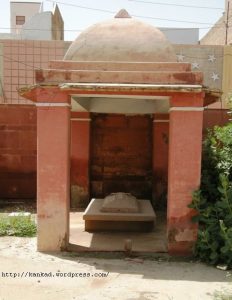
थार के इतालवी साधक का स्मृति स्थल
भारतीय सभ्यता व संस्कृति में विशेष रुचि रखने वाले टेस्सिटोरी ने खुद को थार की विकट जलवायु के अनुसार ढाला और यहां की संस्कृति में ऐसे रचे बसे कि यहां के ही होकर रह गए। महाराजा गंगासिंहजी ने उन्हे किले के पास ही राजपूत शैली की छतरी की समाधी में दफनाया। बीकानेर में टेस्सिटोरी के कब्र को स्मृति स्थल के रूप में विकसित किया गया हैं। 1982 से सालाना टेस्सिटोरी स्मृति समारोह की शुरुआत हुई।
संदर्भ:
-
- Google Search
- Wikipedia
- बीकानेर अभिलेखागार में तैस्सीतोरी कक्ष में उपलब्ध सामग्री पर साभार आधारित
- Progress Report on the Preliminary Work done in connection with the Bardic and Historical Survey of Rajputana, 1916-1920) and in the «Bibliotheca Indica» (A Descriptive Catalogue of Bardic and Historical Manuscripts, 1917-1918; Vacanikā Rāṭhòṛa Ratana Siṅghajī rī Mahesadāsòta rī Khiṛiyā Jaga rī kahī, 1917 and Veli Krisaṇa Rukamanī rī Rāṭhòṛa rāja Prithī Rāja rī kahī, 1919, critical editions; Chanda rāu Jètā Sī rò. Vīthu Sūjè rò kiyò, also a critical edition, 1920).
Jeevan-yaatra
 Tessitoree ka janm 13 disambar 1887 ko udeen ke uttar-poorvee Itaalavee shahar mein hua tha, jo guilde Tessitoree, phaundaling aspataal ke ek kaaryakarta aur lugiya roja veniyar romaano ke ghar mein hua tha. vishvavidyaalay jaane se pahale unhonne liso klaasiko jaikopo stelinee mein adhyayan kiya. Unhonne phlorens vishvavidyaalay mein adhyayan kar, 1910 mein maanavikee mein apanee digree praapt kee. ve ek shaant chhaatr the aur unhonne sanskrt, paalee aur praakrt ka adhyayan kiya. unakee bhaarateey sanskrti aur saahity mein atyadhik roochee hone ke kaaran unake sahapaathee unhen bhaarateey “luee”/yoddha upanaam se sambodhit karate the.
Tessitoree ka janm 13 disambar 1887 ko udeen ke uttar-poorvee Itaalavee shahar mein hua tha, jo guilde Tessitoree, phaundaling aspataal ke ek kaaryakarta aur lugiya roja veniyar romaano ke ghar mein hua tha. vishvavidyaalay jaane se pahale unhonne liso klaasiko jaikopo stelinee mein adhyayan kiya. Unhonne phlorens vishvavidyaalay mein adhyayan kar, 1910 mein maanavikee mein apanee digree praapt kee. ve ek shaant chhaatr the aur unhonne sanskrt, paalee aur praakrt ka adhyayan kiya. unakee bhaarateey sanskrti aur saahity mein atyadhik roochee hone ke kaaran unake sahapaathee unhen bhaarateey “luee”/yoddha upanaam se sambodhit karate the.
Bhart Mei pratham niyukti :
 Uttar Bhaarateey sthaaneey bhaashaon mein ek abhiruchi vikasit hone ke baad, Tessitoree ne raajasthaan mein ek niyukti praapt karane ke lie kadee mehanat kee. Unhonne 1913 mein indiya ophis mein aavedan kiya, yah samajhate hue ki naukaree kee koee gaarantee nahin thee. Unhonne bhaashaee kaary kee niyukt ke lie bhaarateey raajaon se bhee sampark kiya. Is samay ke dauraan, unhonne ek jain shikshak, vijaya dharm suri (1868-1923) ke saath sampark sthaapit kiya, jinake saath unaka ghanishth vyaktigat aur vyaavasaayik sambandh the. Suri Jain saahity ke apane gahan gyaan ke lie jaane maane jaate the aur unhone jain saahity ke kaee kaaryon kee punarpraapti aur sanrakshan mein mahatvapoorn bhoomika nibhaee thee. Suri ne unhen raajasthaan ke ek jain skool mein ek pad kee peshakash kee. ek videshee eesaee ka, jain samudaay mein rahane vaalee naajuk sthiti ke baare mein jaanate hue bhee Tessitoree ne indiya ophis se aavedan kar ke sveekrti praapt kee aur ve 1914 mein bhaarat aa gaye. Bhaarat pahuchanne par ve bhaashaee sarvekshan aur puraatatv sarvekshan donon ke saath ghanishth roop se jud gaye aur unake dvaara kiya anaveshan Indolojee ya Bharat-vidya ke lie ek maulik mahatv kee khoj ban gaya.
Uttar Bhaarateey sthaaneey bhaashaon mein ek abhiruchi vikasit hone ke baad, Tessitoree ne raajasthaan mein ek niyukti praapt karane ke lie kadee mehanat kee. Unhonne 1913 mein indiya ophis mein aavedan kiya, yah samajhate hue ki naukaree kee koee gaarantee nahin thee. Unhonne bhaashaee kaary kee niyukt ke lie bhaarateey raajaon se bhee sampark kiya. Is samay ke dauraan, unhonne ek jain shikshak, vijaya dharm suri (1868-1923) ke saath sampark sthaapit kiya, jinake saath unaka ghanishth vyaktigat aur vyaavasaayik sambandh the. Suri Jain saahity ke apane gahan gyaan ke lie jaane maane jaate the aur unhone jain saahity ke kaee kaaryon kee punarpraapti aur sanrakshan mein mahatvapoorn bhoomika nibhaee thee. Suri ne unhen raajasthaan ke ek jain skool mein ek pad kee peshakash kee. ek videshee eesaee ka, jain samudaay mein rahane vaalee naajuk sthiti ke baare mein jaanate hue bhee Tessitoree ne indiya ophis se aavedan kar ke sveekrti praapt kee aur ve 1914 mein bhaarat aa gaye. Bhaarat pahuchanne par ve bhaashaee sarvekshan aur puraatatv sarvekshan donon ke saath ghanishth roop se jud gaye aur unake dvaara kiya anaveshan Indolojee ya Bharat-vidya ke lie ek maulik mahatv kee khoj ban gaya.
Maan kee gambheer beemaaree kee khabar pa kar ke ve 17 aprail 1919 mein italee ke lie ravaana hue. lekin jab tak ve italee pahunche, tab tak unakee maan ka dehaant ho chuka tha. kaee maheenon tak italee mein rah kar jab ve navambar mein jahaaj se bhaarat laut rahe the tab durbhaagy se unhe spenish inphlooenja ho gaya aur ve gambheer roop se beemaar pad gaye. 22 navambar 1919 ko beekaaner mein unakee mrtyu ho gaee.
Shodh aur praarambhik kaary

Vaalmeeki aur Tulasidasji ki Raamaayan par Shodh:
Tessitoree kee videshee bhaashaon mein svaabhaavik ruchi thee aur vishvavidyaalay star par sanskrt ka adhyayan karane ke baad ve phlorens vishvavidyaalay se sanskrt ke snaatak bhee hue. 1846 aur 1870 ke beech Vaalmeeki Raamaayan ke bangaalee ya gauda sanskaran ke baarah khand italee mein gaisper goresiyo dvaara prakaashit kie gae the. jo itaalavee indeelojist ke lie ek mahatvapoorn sandarbh ban gaye.
Tessitoree kee theesis bhee inake kaam par aadhaarit thee. Unhone isamen vaalmeeki aur tulaseedaas ke sanskaran ke beech ke sambandh ka vishleshan kiya tha. unhonne isamen darshaaya ki lagabhag ek hajaar saal baad avadhee mein likhee gaee raam-charit maanas mein tulaseedaasajee ne vaalmeeki se mukhy kahaanee udhaar lee aur phir apanee roochee ke anusaar vishay ka vistaar ya kam kar ke, ek kaavyaatmak roop mein prastut kiya jo ki mool roop se svatantr tha aur isalie ise ek naya kaam maana ja sakata hai. Unhone do sanskaranon kee kavita-pady kee tulana kar ke apane shramasaadhy shodh mein yah darshaaya ki tulaseedaasajee ne us samay bhaarat mein maujood raamaayan ke vibhinn sanskaranon ka anokha mishran kiya tha. Unakee theesis paolo emiliyo paavolinee kee dekharekh mein prakaashit huee. unhone 24 saal kee umr mein hee ‘Raamacharit aur Raamaayan’ vishay par pahale Itaalavee shodhaarthee hone ka gaurav praapt kiya.
Bhashaee sarvekshan mein yogadaan
 Bharat Mei Aagman:
Bharat Mei Aagman:
Eshiyatik sosaitee of bangal ne Tessitoree ko apane bhaashaee sarvekshan mein shaamil hone ke lie aamantrit kiya. unhen sar jorj griyarsan dvaara rajaputaana ke kavi ya bhaat sambandhee bardik aur aitihaasik sarvekshan ka netrtv karane ka kaam saumpa gaya tha. ve 8 april 1914 mein aae aur paanch saal tak raajaputaana mein rahe. unhonne rajasthaan ke madhyayugeen kaal aur kavitaon ka anuvaad kiya aur un par tippanee kee, jinamen se kaee ka adhyayan unhonne pahale phlorens kee raashtreey pustakalay mein kiya tha. Unhone kaee saahityak rachanaon ka samaalochanaatmak aur samekshatmak sampaadan kiya. jaise raathaud prthveeraaj (vi. 1606) dvara veli krisan rukmanee ree, charan daas (1760-1836) kee naasaket ree aur beethoo soojo(1598) kee raav jaitasee ro chhand ityaadi.
Tessitoree ne dingala aur pingala boliyon aur vanshaavalee kathaon mein kaavy rachanaon kee khoj kee. unhonne kuchh naukarashaahee virodh ke baavajood nijee baardik laibreree aur kaee raajakeey pustakaalayon ko soocheebaddh karane mein kaamayaabee haasil kee.
Purani Gujarathi aur purani paschami rajasthani ka tulanatamk Adhyann:
1915 mein, beekaaner ke mahaaraaja dvaara aamantrit, Tessitoree raajasthaan pahunche aur kshetreey saahity ka koshagat (leksikograaphik) aur vyaakaranik adhyayan shuroo kiya. vah yah dikhaane mein saksham huye ki puraanee gujaraatee naamak bolee ke bolane ka dhang se use puraanee pashchimee raajasthaanee kaha jaana chaahie. ve raajasthaanee boleeyon kee sundarata se atay adhik prabhaavit the. Unhonne puraanee raajasthaanee ke vyaakaran ka, usee tulanaatmak paddhatiyon ke saath adhyayan kiya jaisa ki unhonne apanee theesis ya shodh ke saath kiya tha. is tarah unhone aadhunik indo-aaryan varnaakyoolar ya jaateey praakrt bhaasha ke vikaas ke itihaas kee neenv rakhee.
Baardik Sangrahlay ya Laibrary:
Janha mahakavy ya veer kavitaayen, jinako aksar veena, geet, ya kisee bhee tareeke se ga kar sunaaya jaaye, un rachanaon ka sangrahit karke rakha gaya ho. ek praacheen seltik sangeetakaar aur kavita ke lekhakon ke kram mein se koee bhee kavi jaise baard, william shekspiyar.
beekaaner ke prasiddh abhilekhaagaar mein Tessitoree abhilekh kaksh bana hua hai jisamen un se judee tamaam saamagree ka pradarshan kiya gaya hai. Is kaksh kee saamagree hajaaree laal baanthiya ne upalabdh karaee hain.
Puraatattv mein yogadaan:
Doctor luigee piyo Tessitoree jab praacheen bhaarateey granthon mein kuchh shodh kar rahe the tab us kshetr ke khandaharon kee maury poorv kaal aur hadappa sanskrti kee samaanata se ve hairaan the. unhonne bhaarateey puraatatv sarvekshan ke sar jon maarshal se madad maangee. jo us samay e.es.aaee. hadappa mein khudaee kar rahe the, lekin ve khandaharon ke mahatv se anajaan the.
apane bhaashaee kaary ke saath, Tessitoree ne bhaarateey puraatatv sarvekshan ke sar jon maarshal kee or se smaarak stambhon, moortiyon, sikkon aur puraataatvik sthalon kee khoj mein jodhapur aur beekaaner kee yaatra kee.
 Purve Morya kalin Vastuye:
Purve Morya kalin Vastuye:
Tessitoree ko rangamahal aur any sthaanon ke teelon ke khanan se guptakaal kee terakota vastuyen praapt huee, saath hee gangaanagar ke paas devee sarasvatee kee do vishaal sangamaramar kee moortiyaan bhee. unhen dulaamanee aur gangaanagar mein kushaan-saamraajy ke samay ka teraakota saamaan mila. unhonne jodhapur-beekaaner kshetr mein patthar (govardhan) stambhon aur shilaalekh ya beejalekhon ke lekhon kee sanketaavalee ko hal kar prakaashit kiya. unhonne beekaaner riyaasat ke saikadon gaanvon mein ghoomakar lagabhag 729 puraalekhon aur lagabhag 981 moortiyaan tatha puraatatv mahatv kee any cheejen khoj kar ekatr kee.
Moohare:
Unhonne beekaaner-gangaanagar kshetr mein itihaasonmukh proto-aitihaasik khandaharon ka ullekh kiya, jo sahee roop se ingit karate hain ki ye mauryakaaleen sanskrti ke hain. is khoj ne kaaleebangan kee sindhu ghaatee sabhyata sthal kee khoj aur utkhanan ko saksham banaaya. unhonne 1919 mein italee ke apane sankshipt pravaas ke dauraan sar jorj griyarsan ko patr se, kaaleebangan se milee do vastuon kee khoj ke vishay mein soochit kiyaHe referred to the historically oriented proto-historical ruins in the Bikaner-Ganganagar region, which rightly indicates that they belong to the Mauryan culture. This discovery enabled the discovery and excavation of the Indus Valley Civilization site of Kalibangan. During his brief stay in Italy in 1919, he informed Sir George Grierson about the discovery of two items from Kalibangan. aur bataaya ki,”unamen se pahalee ek muhar hain jis par ankit lekh ko pahachaanane mein asamarth hoon aur doosaree vah vastu khand jis par muhar milee. yah ek atyant dilachasp khoj hai: mera maanana hai ki yah praagaitihaasik ya gair-aaryan ho sakate hain. mujhe sandeh hai ki muhar par ankit lekh shaayad ek videshee jaatee hone kee or sanket karate hain?”
Griyarsan ne sujhaav diya ki vah bhaarat lautane par unhen jon maarshal ko dikhae. jab vah beekaaner vaapas aaye to unake asaamayik nidhan ke kaaran ve aisa nahin kar paaye. seel ke gyaan ko usake saath daphan kar diya gaya aur use tab hee baraamad kiya gaya jab kaanapur ke ek vyaapaaree hajaareemal baanthiya, italee se unake patraachaar kee pratiyaan bhaarat vaapas lae.
 Thar ke Italavi sadhak ka smrti sthal:
Thar ke Italavi sadhak ka smrti sthal:
Bharatiy sabhyata va sanskrti mein vishesh ruchi rakhane vaale Tessitoree ne khud ko thaar kee vikat jalavaayu ke anusaar dhaala aur yahaan kee sanskrti mein aise rache base ki yahaan ke hee hokar rah gae. mahaaraaja gangaasinhajee ne unhe kile ke paas hee raajapoot shailee kee chhataree kee samaadhee mein daphanaaya. Bikaner mein Tessitoree ke kabr ko smrti sthal ke roop mein vikasit kiya gaya hain. 1982 se salana Tessitoree Smrti Samaaroh kee shuruaat huee.
Sandharbh:
-
- Google Search
- Wikipedia
- bikaner abhilekhgar mei tessitori kaksh mei uplabdh samagri
- Progress Report on the Preliminary Work done in connection with the Bardic and Historical Survey of Rajputana, 1916-1920) and in the «Bibliotheca Indica» (A Descriptive Catalogue of Bardic and Historical Manuscripts, 1917-1918; Vacanikā Rāṭhòṛa Ratana Siṅghajī rī Mahesadāsòta rī Khiṛiyā Jaga rī kahī, 1917 and Veli Krisaṇa Rukamanī rī Rāṭhòṛa rāja Prithī Rāja rī kahī, 1919, critical editions; Chanda rāu Jètā Sī rò. Vīthu Sūjè rò kiyò, also a critical edition, 1920).
Journey of Archaeologist Tessitori
Tessitori was born on 13 December 1887 in the north-eastern Italian city of Udine. He was born in the home of a workers Guilde Tessitori and Lugia Rosa Venier Romano at the Foundling Hospital. Before going to university he studied at the Liso Classico Jacopo Stellini. He received his degree in Humanities in 1910, studying at the University of Florence. He was a quiet student and studied Sanskrit, Pali and Prakrit. His classmates used to refer to him by the Indian “Louis” (Warrior) surname as he was very interested in Indian culture and literature.
First Appointment in India:
Having developed an interest in North Indian vernaculars, Tessitori worked hard to obtain an appointment in Rajasthan. He applied to the India office in 1913, realizing that there was no guarantee of a job. He also approached the Indian kings to appoint for linguistic work. During this time, he established contact with a  Jain teacher, Vijaya Dharma Suri (1868–1923), with whom he had close personal and professional connections.
Jain teacher, Vijaya Dharma Suri (1868–1923), with whom he had close personal and professional connections.
Suri was known for his deep knowledge of Jain literature and was instrumental in the retrieval and preservation of many works of Jain literature. Suri offered him a position in a Jain school in Rajasthan unbderstanding the sensitivity and the delicate volatile situation of a foreign Christian living in the Jain community.
Tessitori applied for approval from the India Office and came to India in 1914. On reaching India, he became closely involved with both the Linguistic Survey and the Archaeological Survey and the exploration he undertook became a discovery of fundamental importance to Indology.
He left for Italy on 17th April 1919 after receiving news of his mother’s serious illness. But by the time he reached Italy, his mother had died. Unfortunately, when he was returning to India by ship in November, he got the much dreaded Spanish influenza (like COVID-19) and fell seriously ill. He unfrtunatley died on 22 November 1919 in Bikaner.
Primary Reasearch Work:
 Research on Valmiki and Tulsidas Ramayan:
Research on Valmiki and Tulsidas Ramayan:
Tessitori had a natural interest in foreign languages and after studying Sanskrit at the university level, he also graduated from Sanskrit from the University of Florence. Between 1846 and 1870, twelve volumes of the Bengali or Gowda edition of the Valmiki Ramayana were published in Italy by Gaspare Gorescio. This became an important reference for Italian Indologists. Tessitori’s thesis was also based on his work. He analyzed the relationship between Valmiki and Tulsidas’s version of Ramayan in it. He showed that after about a thousand years in the Ram-Charit Manas written in Awadhi, Tulsidasji borrowed the main story from Valmiki and then presented it in a poetic form, expanding or reducing the subject according to his interest, and wished it to be considered a new work.
In his painstaking research Tessitori compared both volumes’ poetry; he established that Tulsidasji had made a unique mixture of different versions of the Ramayana which were very popular at that time in India. His thesis was published in under the supervision of Paolo Emilio Pavolini. At the age of 24, he had the distinction of being the first Italian researcher on the topic ‘Ramcharit and Ramayana’.
Contribution to Linguistic Survey
 Arrival in India:
Arrival in India:
The Asiatic Society of Bengal invited Tessitori to join its linguistic survey of India. He was tasked by Sir George Grierson to lead the Bardic and Historical Survey of the Poets or Bhats of Rajputana. He came on 8 April 1914 and lived in Rajputana for five years. He translated and commented on the medieval period and poems of Rajasthan, many of which he had previously studied in the National Library of Florence.
Tessitori discovered poetic compositions in the Dingla and Pingala dialects and genealogical stories. He succeeded in cataloging the private Bardic Library and several state libraries despite some bureaucratic opposition. He has critically edited many literary works. Such as Veli Chrisan Rukmani Ri by Rathod Prithviraj (v. 1606), Nasket Ri of Charan Das (1760-1836) and Chanda Rao Jaitsey Ro of Beethu Sujo (1598).
Comparision Between old Gujrathi and Old Western Rajasthani Dialiect:
In 1915, invited by the Maharaja of Bikaner, Tessitori arrived in Rajasthan and began a lexicographic and grammatical study in the regional literature. He was able to show that the manner of speaking of old Gujarati dialect was actually old Western Rajasthani. He was taken aback by the beauty of Rajasthani dialects. He studied the grammar of old Rajasthani dialect with the same comparative methods as he did with his thesis or research. In this way he laid the foundation for the development of modern Indo-Aryan Vernacular or ethnic Prakrit language.
Bardic Library:
A collection of those epic or heroic poems, which are often sung by lyre, song, or in any manner. An ancient Celtic composer and poet of the order of authors of poetry such as, Bard, William Shakespeare. In the famous archives of Bikaner, there is a Tessitori inscription room which displays all the material attached to them. The contents of this room are made available by Hazari Lal Banthiya.
Archaeological Contribution
Discovery of Indus Valley Civilization site of Kalibangan: When Tessori was doing some research in ancient Indian texts, he was surprised by the similarity of the ruins of that region to the pre-Mauryan period and the Harappan culture. He sought help from Sir John Marshall of the Archaeological Survey of India (ASI). ASI had discovered Harappa by that time but were however unaware of the importance of its ruins.
Along with his linguistic work, the Tessitori traveled to Jodhpur and Bikaner in search of memorial pillars, statues, coins and archaeological sites on behalf of Sir John Marshall.
Pre Mauryan objects:
Tesitori received the Gupta terracotta objects from the mining of dunes of Rang Mahal and other places, as well as two huge marble statues of Goddess Saraswati near Ganganagar. They found terracotta item of the Kushan-empire at Dulamani and Ganganagar. He published by resolving the signatures of the stone (Govardhan) columns and inscriptions or articles of cipheries in the Jodhpur-Bikaner region. He roamed and covered hundreds of villages of the princely state of Bikaner and collected about 729 archival items and about 981 statues and other things of archaeological importance.
Seal:
He referred to the historically oriented proto-historical ruins in the Bikaner-Ganganagar region, which rightly indicates that they belong to the Mauryan culture. This discovery enabled the discovery and excavation of the Indus Valley  Civilization site of Kalibangan. During his brief stay in Italy in 1919, he informed Sir George Grierson about the discovery of two items from Kalibangan. And told that, “The first of them is a seal on which I am unable to recognize the inscribed article and the second is the section on which the seal was found. This is an extremely interesting discovery: I believe it may be prehistoric or non-Aryan. I suspect that the inscriptions on the seal may indicate an alien race? “
Civilization site of Kalibangan. During his brief stay in Italy in 1919, he informed Sir George Grierson about the discovery of two items from Kalibangan. And told that, “The first of them is a seal on which I am unable to recognize the inscribed article and the second is the section on which the seal was found. This is an extremely interesting discovery: I believe it may be prehistoric or non-Aryan. I suspect that the inscriptions on the seal may indicate an alien race? “
Grierson suggested he show it to John Marshall when he returned to India. When he came back to Bikaner, he could not do so due to his untimely demise. Seal’s knowledge was buried with him and recovered only when Hazarimal Banthiya, a merchant from Kanpur, brought back copies of his correspondence from Italy to India.
 Memorial site of Thar’s Italian seeker:
Memorial site of Thar’s Italian seeker:
Tessitori, had a special interest in Indian civilization and culture, he molded himself according to the harsh climate of the Thar and Rajasthni culture and become one of them. Maharaja Gangasinghji buried him in the tomb of Rajput style umbrella near the fort. The tomb of the Tessitori in Bikaner has been developed as a memorial site. In his memory was started the annual Tessitory Memorial Festival in 1982.
References:
-
- Google Search
- Wikipedia
- Bikaner Museum
- Progress Report on the Preliminary Work done in connection with the Bardic and Historical Survey of Rajputana, 1916-1920) and in the «Bibliotheca Indica» (A Descriptive Catalogue of Bardic and Historical Manuscripts, 1917-1918; Vacanikā Rāṭhòṛa Ratana Siṅghajī rī Mahesadāsòta rī Khiṛiyā Jaga rī kahī, 1917 and Veli Krisaṇa Rukamanī rī Rāṭhòṛa rāja Prithī Rāja rī kahī, 1919, critical editions; Chanda rāu Jètā Sī rò. Vīthu Sūjè rò kiyò, also a critical edition, 1920).


